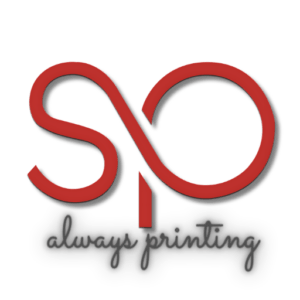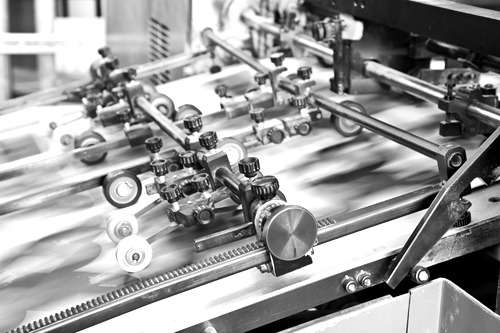1. Resolution Matters
The best resolution for designing artwork is 300dpi. This ensures no pixelation and high quality printing of vectors and images.
- DPI is the number of pixels that would be needed for printing 1 inch (2.54cm)
- Try to design your own graphics for printing if possible. If you are not able to, make sure the graphics being used in the design is a vector or image with high quality resolution.
| Inches (in) | Centimetres (cm) | Millimetres (mm) | Dots per an Inch (DPI) / Pixels per an Inch (PPI) |
|---|---|---|---|
| 1×1 | 2.54×2.54 | 254×254 | 300×300 |
| 2×2 | 5.08×5.08 | 508×508 | 600×600 |
| 3×3 | 7.62×7.62 | 762×762 | 900×900 |
2. Use CMYK Colour Mode
- When designing the item to be printed for litho print specifically, it is necessary to use CMYK colour codes for the design (not RGB or HEX colour codes). This ensures that your colours are accurately represented in print. RGB is more suitable for digital screens, while CMYK is optimised for printing.
- If you have a simple design that does not require a CMYK print, offset litho is able to do this by just having a spot colour artwork so it will be a one colour print. But when designing, this spot colour should still be in the CMYK colour mode and selected as a spot colour so that the computer does not pick it up as a CMYK black (In which case there will be tiny percentages of cyan, magenta and yellow).
3. Mindful of Bleed and Trim
Incorporate bleed in your designs to ensure that there are no white borders after trimming. Also, be aware of trim lines to avoid important elements being cut off during the printing process.
Standard bleed is 5mm around all designs.
Most programs for designing print work (Such as Adobe AI or ID) has the function to save your design with a bleed area, a colour bar & tick marks for the trimming of the final print.
4. Choose the Right Fonts
Avoid using too many different fonts in a single design. Try and use fonts that will be legible for printing. Be aware that fonts that are too thin or intricate may have trouble printing, especially if it is in CMYK. If using thin or intricate fonts, it is always recommended to have this done as a spot colour to ensure it is a solid colour when printed.
5. Consider Paper and Finishes
Keep in mind the type of paper you’ll be printing on and adjust your design accordingly. Also, consider finishes like gloss or matte for an extra touch. SpectraPrint’s expertise in this area can certainly enhance the final product.
There are many different types of paper to choose from, ranging from the standard art papers that are either gloss or matte, sulphate boards that have gloss on one side and matte on the reverse, as well as special artisan papers like metallic papers and papers with different textures. Standard art paper is the most affordable, while more speciality papers become more expensive. You can have a look through our paper guide here.
There are a variety of different finishes to choose from when using offset lithography. Finishes such as laminating, spot UV and foiling can make your design pop out. We have some examples of the different types of finishes available here.
6. Check Colour Consistency
Ensure colour consistency across your design. Use swatches and colour profiles to guarantee that the colours you see on your screen will closely match the printed result. As mentioned above, be aware of the colour mode selected when designing – the colour outputs on computer screens can be very different to the final printed product.
It’s also important to consider the lighting where your prints will be displayed. Natural light gives the best look to printed items, while fluorescent lighting and LED lighting may give the colour a slightly different tone.
7. Think About Typography
Pay attention to line spacing, kerning, and leading to ensure that your text is easy to read. Avoid putting important information too close to the edges to prevent it from being trimmed off.
8. Test with a Proof
Before going for a full print run, request a proof to check for any unexpected issues. This allows you to make adjustments and ensures the final product meets your expectations. Low resolutions proofs are great for checking wording, spacing and overall feel of the design while high resolution proofs provide more detail to the colour and overall look of the design. However, be mindful that high resolution proofs are generally done on a digital printing machine which means RGB colour mode was used so the colour itself can be slightly different to the final print.
When requested, low resolution proofs are provided free of charge whereas high resolution proofs will be charged.
9. Keep it Simple
Sometimes less is more. A cluttered design can be overwhelming and might not translate well into print. Focus on key elements that convey your message effectively. It is always a good idea to chat to the production manager to get their take on the design and how it may print.
10. Understand Print Techniques
Familiarise yourself with different print techniques, such as spot colour or metallic inks, and consider how they might enhance your design.
If you have colours in your design that are crucial for your brand that doesn’t convert well to a CMYK colour, then you can have additional colours called spot colours. These spot colours will be matched to a pantone that will then be printed with your CMYK design.
In terms of quoting, it is always necessary to include your colour requirements. If you have additional spot colours, this will be quoted as “4 Process Colours (CMYK) + 1 Spot Colour”. As offset litho works with plates to get the design onto the paper, each plate is used for a colour therefore an extra plate would have to be added for the spot colour. You can have as many spot colours as you like, but it is important to note that this will increase the cost of the print.
Spot colours are also a great option if you would like metallic, fluorescent or pastel colour used in the design. These inks are slightly more expensive than regular inks and pantones, but they are specially formulated for the purpose of having it stand out.


Leave a Reply